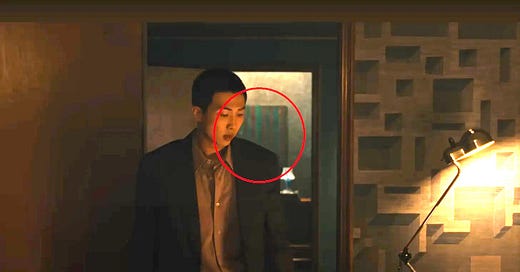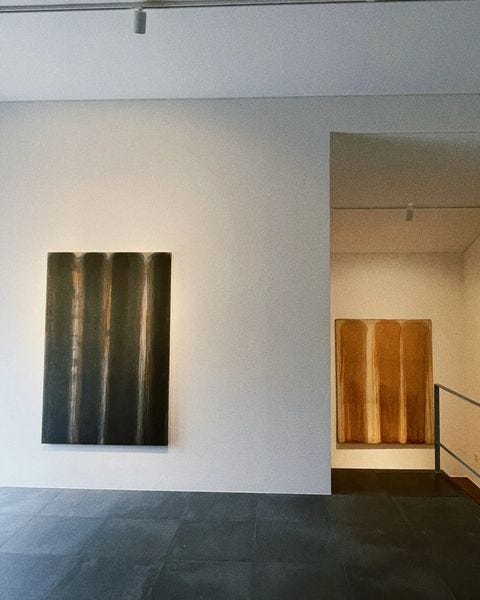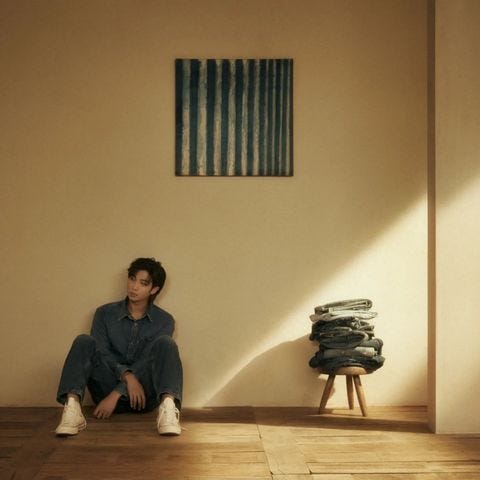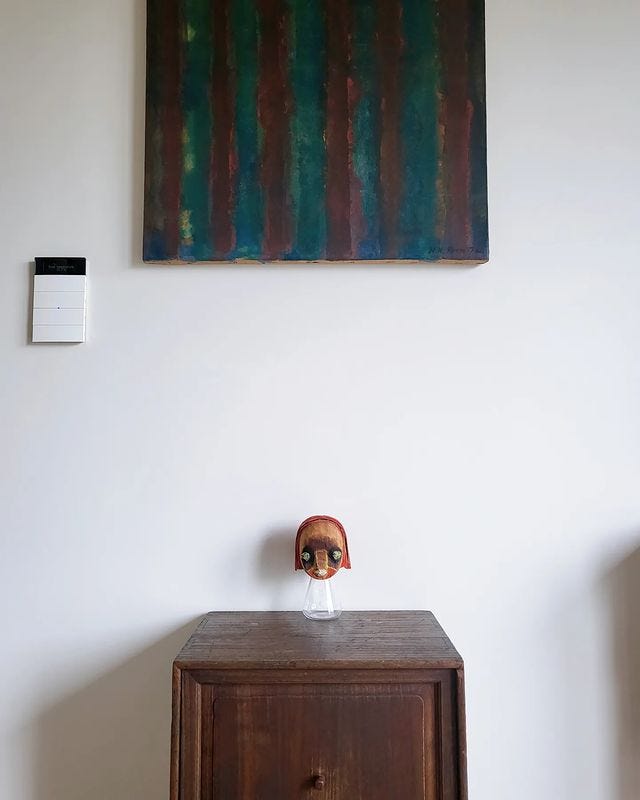Right Place, Wrong Painting? Yun and RM's RPWP
Kim Namjun snuck a Yun Hyong-keun painting in the Come Back to Me MV, but not the one you think. So what does it mean?
In honor of the release of the RPWP (Right Place, Wrong Person) documentary, please enjoy the first entry in a series on the second full-length solo studio album from RM of BTS. s leader RM has a longstanding relationship with the world of fine art, a push-and-pull where he is both inspired by visual arts and impacts the industry with his choices in collecting and attending shows. So it should come as no surprise that there are fine art references across his most recent solo album’s promotions. Audacious, playful, inventive, and vulnerable, RPWP has music videos to match, and an artistic easter egg in the music video for Come Back to Me suggests how to read RM’s Right Place, Wrong Person within the BTS leader’s overall body of work. As RM’s character moves from one room to another in a home filled with touches of modern design that closely follow his own taste, he seemingly jumps from one version of his life to another, one parallel universe to another. Early on, RM’s character comes into the bedroom looking confused and ducks to miss a projectile his apparent wife throws at him. Over his shoulder we can see an oil painting by Yun Hyong-keun, RM’s favorite artist, for whom he named a song on his last album, Indigo.
Yun Hyong-keun (1928-2007), a Korean abstract painter emblematic of the Dansaekhwa movement, a post-war Korean contemporary art movement focused on abstract monochromatic works. Rejecting formalism and realism, Dansaekhwa artists grappled with their country’s uncertain sense of identity—for Yun, that meant mixing Korean and broader Asia tradition with Western modernism. A political prisoner of his own country multiple times, Yun was an artist at a time when that was a very dangerous thing to be in South Korea.
Yun’s characteristic burnt umber paintings were created by pouring layer upon layer of oil paint in just the two colors—umber brown and ultramarine blue—on linen or cotton canvas. At times he would add new layers while the paint was still wet or use turpentine to alter it after application. The process was similar to one used by his father-in-law and teacher Kim Whanki, working on Korean mulberry paper. The result is dark, dark, dark rectangular forms, often columns standing tall or tumbling together, with edges that recede lighter into the canvas as the layers of paint bleed together and seep into the material. The monochromatic browns feel organic, and not a trace of blue can be detected. It’s a key ingredient, foundational even. But the blue is sublimated into the final result, imperceptible except to the expert eye—and those who understand the process necessary to arrive at the result. Whatever comes next in RM’s career, it never could have happened without the versions of him that have come before, as a person, poet, and musician.
Getting back to RPWP, fans of RM might be surprised that the painting shown in “Come Back to Me” isn’t “Blue” (1972), the Yun piece from the Indigo album artwork. It’s actually from RM’s own collection ("Blue” was on loan), as shown on his instagram. “Blue” has light spaces between its stripes, whereas this painting appears to feature ultramarine and umber alternating with one another, making for an overall darker work. The stripes in “Blue” are also more numerous and more varied, both in terms of width and distance between one another, which is further from the eventual style of the burnt umber paintings. In the painting in the music video the two colors aren’t yet layered on top of one another to create the dark, almost black, mix, but they’re commingling where the stripes spill over into one another. The transformation isn’t quite complete, but the two colors are both present, and they’re close together.
Symbolically, RM used “Blue” for Indigo because it was Yun's last painting before he found his signature burnt umber style. When RM kept saying that during press for Indigo, I remember thinking how stressful! That puts a lot of pressure on the next album. But of course, Kim Namjun was playing chess, not checkers. He was already working on the next album, so he knew that it wasn't going to be his burnt umber, but another, different, striped ultramarine. RM certainly owns burnt umber works by Yun that he could have included one in the “Come Back to Me” MV if he wanted.
That means that RPWP is not yet RM’s signature style. It is instead something of an experiment, one last bite of the same apple, but this time a little deeper, a little more frenzied and intense. Less neat and predictable. And with the inclusion of burnt umber alongside ultramarine, it’s just that much closer visually to Yun’s signature style, to the two colors being on top of one another.
In many ways, RPWP is a companion album to Indigo, a necessary transition step before whatever comes next. It treads similar subject matter while going farther, revealing more, and pushing into more interesting territory both musically and in terms of emotional vulnerability. Indigo was careful, precise, ready for scrutiny. RPWP is looser, more open, purposefully discordant, humorous in its anger, with a deeply foreboding front side and a loud, up-tempo, IDGAF back half. It sounds a bit shaggy and jangly, though that's a deceptive trick of craft; this sound wasn't achieved by accident, even if—at times—it sounds improvised or freewheeling.
RPWP stands out in RM’s body of work as the entry that is most intensely a concept album, a work meant to be experienced front to back, with several songs blending from one to the next, like the transition from “out of love” into “Domodachi feat. Little Simz,” or the way that “Groin’s” intro almost feels like a separate song that happens to go with the next one particularly well. While the rapper asked the audience to listen to Indigo in order, it was essentially a polite request. Here he has stepped it up; to listen to RPWP on shuffle feels utterly bonkers. RPWP is telling a story from its disquieting start to a humble query as the credits roll and the postscript that follows.
Musically, RPWP is a natural progression of RM’s work, albeit one where he's stepping on the metaphorical gas—and maybe not wearing a seatbelt. Among his four solo albums and significant work as one of BTS’s most prolific writers, RPWP stands out for its increased use of instruments, an enveloping atmospheric quality, and layered, experimental, abstract, and even atonal or discordant sound. RM pushes his vocals considerably on RPWP, without sounding strained. It's reminiscent of some of his best vocal performances, like on BTS’s Run (Ballad Mix) and unofficial recordings Fools, and I Know/So That I Love You with fellow BTS member Jungkook.
The album is worth listening to with high quality headphones so you can pick up more of the various layers of sound throughout—after all, a quick tour of Bangtan credits will show that Kim Namjun has always been the king of gang vocals. But much of it is meant to be indistinguishable, allowed to wash over the senses as an overall effect rather than picked apart word by word. Think of it as the auditory equivalent of a massive, abstract color field painting. More than anything since RMixtape, RPWP begs to be played live, with a thrumming crowd jumping, screaming, and dancing along. Here's hoping RM will one day play the album and the rest of his solo work for more than the one-off shows like All Force One and the intimate show at Rolling Hall.
With visual artists, I find myself drawn to their later, weirder, most experimental phases. The burnt umber forms, the all-over-dot paintings, the Rothko Chapel murals, the move to further abstraction, the push to distill their imagery down to its barest and boldest parts. Whether it’s due to a life full of learning, the freedom that comes with cultural caché and/or financial security, or even health issues and the reality of aging necessitating changes in process or style, an artist’s later years can be incredibly rich, especially when they get a little weird with it. RPWP is another shade of RMs blues, deeper in color and a bit more unexpected, yet still closer to an unnamed goal of which he might not even be entirely certain. And if this isn't RM's final, characteristic style yet, if his most experimental and abstract work is yet to come, then I can't wait. Not everyone continues to push themselves, but for those who do, it can be incredibly fruitful. Here's hoping that's where RM and his colors are headed.








